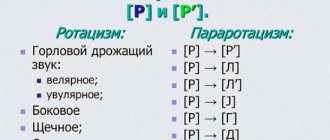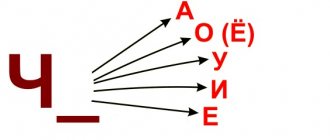Sound setting [Y]
Set of exercises:
- "Let's brush our teeth"
- "needle",
- "slide",
- "coil",
- "tongue is strong."
Methods and techniques for producing sound [Y].
It is often possible to create a sound by imitation. It is useful to add the display of articulation and the tactile sensation of the expiratory stream during prolonged pronunciation [yyy].
The child pronounces the combination [aia] or [ia] several times. The exhalation intensifies somewhat at the moment of pronouncing [i], and immediately, without interruption, [a] is pronounced. You can put the sound immediately in words where the [th] sound is first.
The child pronounces the syllable [zya], repeating it several times. During pronunciation, the speech therapist presses the front part of the back of the tongue with a spatula, moving it back slightly until the desired sound is obtained.
When pronouncing the sound [хь] for a long time, pay attention to the very thin gap between the teeth and increased exhalation.
If the sound [th] is replaced by the sound [l], differentiation should be made by lowering the tip of the tongue down with a spatula or as shown.
Setting sounds [K], [G], [X]
Set of exercises:
- "slide",
- "coil",
- "painter",
- gargling,
- coughing.
Ways and techniques of making sounds k, g, x.
The sound [X] is made by imitation of the “let’s warm our hands” exercise. Open your mouth two fingers and blow warm air onto your palms. In some cases, tilting your head up helps.
The sound [К] (кь) is placed from the sound [т] (ть) with mechanical help. The child pronounces the syllable [ta] (tya) several times; at the moment of pronouncing, the speech therapist uses a spatula or probe to move the tongue deeper into the mouth by pressing on the front part of the back of the tongue. First one hears [ta], then [tya – kya – ka].
Sound [G]. Sometimes it’s easier to first put the sound [g] from [s]. The child throws back his head and pronounces [yyy] with a strong exhalation, while slightly pushing his lower jaw forward, lowering and raising it - “the bear growls.”
If the sound turns out to be South Russian.
It happens that even the sound [x] is pronounced without raising the back of the tongue and part of the air passes into the nose, so the air flow should be controlled by slightly pinching the nose.
The sound [X] is placed from the sounds s and w mechanically - at the moment of their pronunciation, move the tongue deeper into the mouth. The sound g is placed from the sound d in the same way as the sound k.
Setting sounds [Р], [Рь]
A set of exercises for the sounds Р, Рь:
- "needle",
- "fast snake"
- "turkey poults"
- "bucket"
- "horse"
- "painter",
- "woodpecker",
- "steps"
- "drummer",
- "balalaika".
Methods and techniques for producing sounds [P], [Pb].
By imitation.
The child is asked to perform the “mushroom” exercise. At the moment of suction, ask to blow forcefully on the tip of the tongue. A voice is added to the resulting dull vibration.
When the upper elevation of the tongue is set, the child is asked to pronounce the combinations: jzhzh, zhzhzh, or d-d-d-d. At this point, use a spatula, ball probe or clean finger to make quick movements from side to side along the bottom of the tongue closer to the tip.
For spasticity of the tongue root, this technique is used while lying down.
In a similar way, you can call [P] from [Z] the upper rise. The child is asked to hold his tongue at the base of the upper teeth and pull out the sound [З] for a long time. During its pronunciation, the tip of the tongue is in a more tense state and the air stream is more forced. The resulting sound is not clear, but rather noisy. The resulting sound mechanically causes a trembling [P].
When pronouncing [P] in the throat, the production takes place in 2 stages.
Setting up a single-strike [P] from the sound [Zh]. When pronounced in a drawn-out manner, without rounding the lips, moving the tongue slightly forward, towards the gums of the upper teeth. In this case, the sound is pronounced with significant air pressure and a minimal gap between the front edge of the tongue and the gums. Then the placement is carried out using a probe as in other cases.
The most common technique is the production of [D], repeated on one exhalation, followed by a more forced pronunciation of the latter.
When pronouncing the combination [tdtdtdtd] repeatedly, with the mouth slightly open and when the tongue is closed with the gums, vibration occurs. However, this method is not suitable for correcting velar or velar [P].
When the mouth is closed with teeth tightly clenched, sometimes in combination [tr] a voiceless [r] (prodental) is heard. You can make a sound from it if, while pronouncing this combination, you gradually open your mouth, pushing a spatula between your teeth.
To maintain the upper elevation of the tongue, use the “turkey poult” exercise. When quickly pronouncing the combination [blblbl], the lower lip is first lowered (the tongue moves along the upper), then the movements are transferred to the upper incisors, and then to the alveoli. This sound turns out to be slightly burry. To eliminate this defect, you should ask the child to fixate a strong exhalation on the sound d.
If the child does not maintain the upper position of the tongue, and the sound comes out dull and not booming, you can ask the child to “extend” the sound – drn – drn (“start the car”).
Staging other sounds
Sound setting [U].
Stretching your lips forward, pronounce the sound [u], then close and open your lips with your fingers. Or do the “balalaika” exercise with your fingers on your lips at a faster pace. The sound can be immediately entered into words: paper, Pinocchio, etc.
When replacing [B] with [P], you should initially teach: to distinguish sounds, to distinguish incorrect pronunciation from correct, to teach to include the voice at the stage of preparing the articulatory position.
Sound setting [B].
Stretching your lips forward, pronounce the sound u, then mechanically press your lower lip to your teeth.
Bite the edge of your lower lip, slightly stretch your lips into a smile and hum, then sharply open your mouth and say [A]. Particular attention should be paid to the duration and force of exhalation on the lower lip.
Sound setting [D].
- Pronounce the sound [B] with your tongue stuck between your teeth, then use your fingers to spread your lips.
- From the sound [Z] or [Zh]. At the moment of pronouncing, use sharp movements of the spatula to press the tip of the tongue against the alveoli.
Setting sounds [Ш], [Ф], [Ч]
A set of exercises for producing the sounds Ш, Ж, Х:
- "bowl",
- "delicious jam"
- "fungus",
- "harmonic",
- "horse"
- "focus",
- “punish the disobedient tongue.”
Methods and techniques for producing sounds [Ш], [Х], [Ч].
By imitation.
Sound [Ш]. Ask the child to lift his tongue with a scoop over his upper teeth. While holding this position, pronounce the sound [s], paying attention to the fact that the sound [sh] is heard.
The child pronounces the syllable [sa] several times, and the speech therapist gently raises the tip of the tongue with a spatula or probe towards the alveoli. Then you need to blow strongly on the tip of your tongue, adding the sound [a] to the exhalation.
When the sound r is intact, the child pronounces the syllable [ra], and at this moment the speech therapist touches the lower surface of the tongue with a spatula or probe to slow down the vibration. Or they ask you to pronounce the sound [r] as quietly as possible.
When pronouncing the sound x, which produces a strong air stream, the child is asked to raise his wide tongue to the alveoli. However, so that the resulting sound does not remain rear-lingual, it is necessary to focus on the tip of the tongue.
If, when the tongue is raised, its lateral edges are not adjacent to the upper molars, then the thumbs of both hands press it on both sides. Or, standing behind the child, insert the index and middle fingers under the tongue and ask to blow on the tip of the tongue.
The child pronounces the sound [t] ([d] for the sound [zh]) for as long as possible, holding the tongue behind the upper teeth. The resulting sound is close to noisy [s]. Then the speech therapist uses a spatula to slightly move the tongue towards the alveoli. The same technique can be used if the child pronounces the sound [h].
The sound [zh] is placed similarly, but with the inclusion of voice.
The sound [h] is easier to place in reverse syllables. To do this, ask the child to pronounce the syllable [at] with a strong exhalation on [t], while slightly stretching his lips forward, and control the exhalation with the palm of his hand.
If a child has the sound [sch], then you can put [ch] from it if the child quickly begins to pronounce the combination [tsch].
From the sound [ts], at the moment of its pronunciation, ask the child to raise the tip of his tongue upward and stretch his lips forward.
In some cases, it is possible to place [h] from the combination [ts]. To do this, fix your lips in the “horn” position and pronounce the combination “like a shot” with a strong exhalation. If the tongue does not rise, use mechanical assistance - a spatula, a probe.
The sound [ш] is placed in imitation of the sound [h] - stretching it out, or from [sh], moving the tongue to the base of the upper teeth.
From the sound [zh], pronouncing it in a whisper.
From the sound [sya] mechanically, lifting the tongue up or showing.
Setting the sounds S, Сь, З, Зь, Ц.
A set of exercises: “spatula”, “punish the naughty tongue”, “brushing teeth”, “the train whistles”, “strong tongue”, “swing”, “angry kitty”, “groove”.
Setting sounds [L], [L]
A set of exercises for the sounds L, L: “needle”, “fast snake”, “turkey poults”, “dipper”, “horse”, “painter”, “woodpecker”, “steps”, “steamer”, “hunter”.
Methods and techniques for producing the sounds L, L..
If there is no sound, production is carried out in 2 stages:
- Setting [l] interdental. The child is asked to pronounce the combination ya. In this case, [s] is pronounced briefly, with tension in the organs of articulation, then pronounce the combination with the tongue stuck between the teeth. When the sound becomes clear, it is necessary to slow down the movement of the lower jaw. In children with an erased form of dysarthria, it is recommended to fix this sound in syllables and words.
- Next, move the tongue to the tooth position, pressing the tongue firmly against the alveoli and pronounce ly-ly-ly.
With nasal pronunciation, production is carried out in the same way as in the absence of sound. First of all, it is necessary to develop the correct direction of the air stream.
Setting the sound [L] during interdental pronunciation. If a child pronounces several groups of sounds this way, special attention is paid to the development of motor skills of the tip of the tongue. The performance is carried out as in his absence. You can use mechanical assistance - use a spatula to lift the tongue by the upper incisors and hold it until this position is fixed in the child.
Setting the sound [L] when replacing [l] with the sound [th].
When replacing [l] with the sound [th], with the mouth open, place a round plastic tube on the middle part of the back of the tongue, and lift the tip of the tongue by the upper incisors.
When replacing the sound [L] with a soft sound [l], you can use probe No. 4. Ask the child to repeat the syllable [la] several times, then insert the probe so that it is between the hard palate and the middle part of the back of the tongue. Press the probe down on the tongue (to the right or left). To lower the middle part of the back of the tongue, you can perform the following exercise: rest your tongue firmly on the upper incisors and pronounce the syllable ky several times. Then sharply open your mouth (you can help by pressing on your chin). This technique is not suitable for children with lateral pronunciation.
When pronouncing [a], you need to “knock” your tongue on the upper incisors. The exhalation should be hot, smooth and continuous.
In some cases, a faster and clearer sound is obtained in the reverse syllable. Pronounce [a] for a long time, then “bite” the tip of the protruding relaxed tongue: [aaall-aaal-aallaallaaa].
From the sound [v] is placed in a mixed way. Ask the child to pronounce the syllable you with his tongue inserted between his lips, then push back the lower lip with your finger.
A similar technique can be used from the combination [bl] (“turkey”). While pronouncing the combinations blblbl, gradually move your lips to the sides and your tongue deep into your mouth (first along the lips - [blblbl], then along the upper teeth and then along the alveoli).
Invite the child to put as much tension as possible in the shoulder girdle area, for which you need to bend your head forward and in this position, sound the sound [l] as low as possible.
Using two fingers - index and ring - apply light pressure on the outside of the neck so that each finger is at a point at the inner edge of the posterior third of the left and right branches of the lower jaw.
When pronouncing a sound from the side, you must first achieve the correct air flow and straight position of the tongue. The child should be switched from incorrect articulation. Methods No. 1, 8,9 are suitable for this.
The main difficulty in producing the sound [L] is that while pronouncing the sound correctly, the child continues to hear his previous sound. Therefore, it is necessary to attract the child’s auditory attention to the sound that is produced at the moment of its production.



